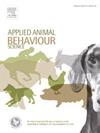Regular play opportunities during the grow-finish phase improve pig trainability and learning in a cognitive bias test
IF 2.2
2区 农林科学
Q1 AGRICULTURE, DAIRY & ANIMAL SCIENCE
引用次数: 0
Abstract
Promoting play behaviour could enhance pig welfare in intensive production systems. Play is associated with positive emotions, and regular play opportunities may positively alter pigs' affective states. The affective state of pigs can be indirectly assessed through a behavioural test that determines an optimistic or pessimistic cognitive bias (CB). This study explored whether grow-finish pigs reared with intermittent play promotion over nine weeks exhibited more optimistic CB compared to conventionally-housed pigs. A subsample of 18 pigs was selected from three treatments (6 pigs/treatment): i) Control (CON), ii) Novelty (NOV), and iii) Play pen (PLP). Play was promoted 3x/week with novel objects provided either in a home pen (NOV, 1 m²/pig) or a larger playpen (PLP, 2.9 m²/pig). At 19 weeks of age, pigs were trained to approach a 'hot spot' (GO/correct) with a positive sound cue (POS) reinforced with a positive reward or avoid it (NO-GO/correct) with a negative sound cue (NEG) reinforced with a negative experience. Afterwards, all pigs' CB was assessed using an ambiguous sound cue (AMB) in two tests (CBT) and GO/optimistic and NO-GO/pessimistic responses were recorded. In training, 66 % of NOV and PLP pigs successfully trained for CBT, while 0 % of CON pigs did (p = 0.036, Fisher’s exact). During testing, the proportion of optimistic responses to the AMB cue exhibited by pigs in trained NOV and PLP treatment groups did not differ from pigs in untrained CON group in CBT 1 (p = 0.751, Kruskal-Wallis) and CBT 2 (p = 0.595). For the POS cue, the proportion of correct responses of trained NOV and PLP treatment pigs was higher compared to pigs from untrained CON group in CBT 1 (at a tendency, p = 0.075) and CBT 2 (p = 0.011). Pigs from the three treatment groups did not differ in their proportions of correct responses to the NEG cue in either CBT. The pig-level proportion of fearful/aggressive behavioural reactions to the negative experience tended to be higher in CON compared to trained and untrained play (PLY) pigs (p = 0.072, Mann-Whitney). Four PLY pigs and one CON pig showed a bold reaction to the negative experience. Results suggest that rearing pigs in a more stimulating environment with play opportunities improves trainability and learning, possibly due to reduced fear. Due to collinearity between treatment and successful training, no conclusions can be drawn about the effect of play promotion on the pigs’ affective states. Future studies should refine CBT methods to enhance understanding of the relationship between play and affective states in pigs.
求助全文
约1分钟内获得全文
求助全文
来源期刊

Applied Animal Behaviour Science
农林科学-行为科学
CiteScore
4.40
自引率
21.70%
发文量
191
审稿时长
18.1 weeks
期刊介绍:
This journal publishes relevant information on the behaviour of domesticated and utilized animals.
Topics covered include:
-Behaviour of farm, zoo and laboratory animals in relation to animal management and welfare
-Behaviour of companion animals in relation to behavioural problems, for example, in relation to the training of dogs for different purposes, in relation to behavioural problems
-Studies of the behaviour of wild animals when these studies are relevant from an applied perspective, for example in relation to wildlife management, pest management or nature conservation
-Methodological studies within relevant fields
The principal subjects are farm, companion and laboratory animals, including, of course, poultry. The journal also deals with the following animal subjects:
-Those involved in any farming system, e.g. deer, rabbits and fur-bearing animals
-Those in ANY form of confinement, e.g. zoos, safari parks and other forms of display
-Feral animals, and any animal species which impinge on farming operations, e.g. as causes of loss or damage
-Species used for hunting, recreation etc. may also be considered as acceptable subjects in some instances
-Laboratory animals, if the material relates to their behavioural requirements
 求助内容:
求助内容: 应助结果提醒方式:
应助结果提醒方式:


